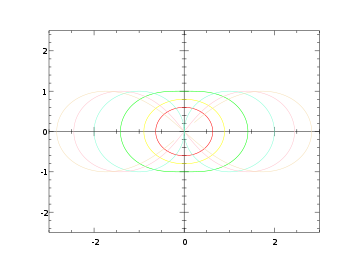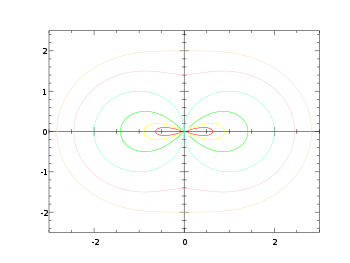- Hippopede
-
In geometry, a hippopede (from ἱπποπέδη meaning "horse fetter" in ancient Greek) is a plane curve determined by an equation of the form
- (x2 + y2)2 = cx2 + dy2,
where it is assumed that c>0 and c>d since the remaining cases either reduce to a single point or can be put into the given form with a rotation. Hippopedes are bicircular rational algebraic curves of degree 4 and symmetric with respect to both the x and y axes. When d>0 the curve has an oval form and is often known as an oval of Booth, and when d<0 the curve resembles a sideways figure eight, or lemniscate, and is often known as a lemniscate of Booth, after James Booth (1810–1878) who studied them. Hippopedes were also investigated by Proclus (for whom they are sometimes called Hippopedes of Proclus) and Eudoxus. For d = −c, the hippopede corresponds to the lemniscate of Bernoulli.
Contents
Definition as spiric sections
Hippopedes can be defined as the curve formed by the intersection of a torus and a plane, where the plane is parallel to the axis of the torus and tangent to it on the interior circle. Thus it is a spiric section which in turn is a type of toric section.
If a circle with radius a is rotated about an axis at distance b from its center, then the equation of the resulting hippopede in polar coordinates
or in Cartesian coordinates
- (x2 + y2)2 + 4b(b − a)(x2 + y2) = 4b2x2.
Note that when a>b the torus intersects itself, so it does not resemble the usual picture of a torus.
See also
References
- Lawrence JD. (1972) Catalog of Special Plane Curves, Dover. Pp. 145–146.
- Booth J. A Treatise on Some New Geometrical Methods, Longmans, Green, Reader, and Dyer, London, Vol. I (1873) and Vol. II (1877).
- Weisstein, Eric W., "Hippopede" from MathWorld.
- "Hippopede" at 2dcurves.com
- "Courbes de Booth" at Encyclopédie des Formes Mathématiques Remarquables
External links

This geometry-related article is a stub. You can help Wikipedia by expanding it.



